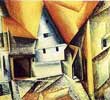Birth Year : 1871
Death Year : 1956
Country : US
Lyonel Feininger was born in New York, the son of two German-born musicians.
He showed talent as a violinist while very young and was sent to Germany
to study music at the age of sixteen. But in Germany, Feininger decided
to study art and, after some preliminary studies, went to Paris where,
like so many artists of the period, he was influenced by Cubism in his
search for his own method of expression. His distinctly personal style
is both Cubist and architectural in derivation. Feininger painted buildings,
churches, town landscapes, or seascapes. These are constructed of transparent
or translucent overlapping geometrical planes that catch light like prisms
or reflect it from solid surfaces. These planes rise up to form an architecture
that continues into a similarly constructed atmosphere, while light pours
through them as if through a series of gauzy veils. His softly muted color
is applied lightly in both oils and watercolors and the resulting works
have the misty iridescent quality of motes of dust in sunbeams.
Franz Marc invited him to join Blaue Reiter,
and so Feininger exhibited with them at the First German Autumn Salon in
1913. He was also one of the four original artists who taught at the Bauhaus,
where he remained until the Nazis closed it in 1933. With Klee,
Kandinsky, and Jawlensky,
Feininger formed a loosely linked group called Die Blallen Vier (The Four
Blues) which exhibited in Germany and the United States beginning in 1924.
Feininger, who also wrote for newspapers, remained in Germany until 1937
when he left for political reasons. Returning to New York he set up a school
of his own in which he taught and painted until his death in 1956.
|
|

Lyonel
Feininger
Old
Locomotive

Lyonel
Feininger
Niedergrunstet

Lyonel
Feininger
Upper
Weimar

Lyonel
Feininger
Arch
Tower I

Lyonel
Feininger
Green
Bridge II, The
View
all Lyonel Feininger
Books
about Lyonel Feininger |